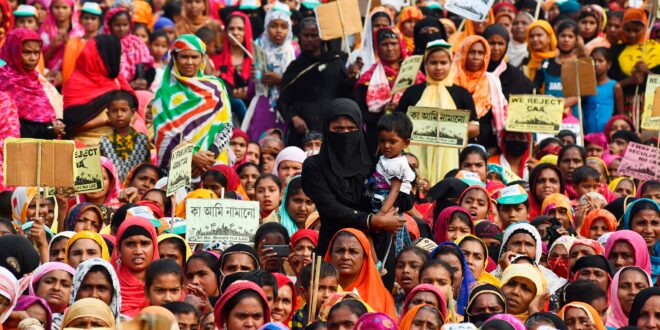Summary
- Some two hundred million Muslims live in India, making up the predominantly Hindu country’s largest minority group.
- For decades, Muslim communities have faced discrimination in employment and education and encountered barriers to achieving wealth and political power. They are disproportionately the victims of communal violence.
- Prime Minister Narendra Modi and the ruling party have moved to further limit Muslims’ rights under the controversial citizenship law, which has the power to render millions of Muslims in India stateless.
Introduction
India is home to some two hundred million Muslims, one of the world’s largest Muslim populations but a minority in the predominantly Hindu country. Since India’s independence, Muslims have often faced discrimination, prejudice, and violence, despite constitutional protections.
Experts say anti-Muslim sentiments have heightened under the leadership of Prime Minister Narendra Modi and the ruling Bharatiya Janata Party (BJP), which has pursued a Hindu nationalist agenda since elected to power in 2014. Since Modi’s reelection in 2019, the government has pushed controversial policies that critics say explicitly ignore Muslims’ rights, restrict religious freedoms, and are intended to disenfranchise millions of Muslims. Under Modi, violence against Muslims has become more common. The moves have sparked protests in India and drawn international condemnation. Some experts who follow India say that Modi’s reelection in 2024 would likely sow further religious division in the country.
Who makes up India’s Muslim population?
India is a country of religious, ethnic, and linguistic diversity. Its Muslims, most of whom identify as Sunni, account for about 15 percent of the population, by far the largest minority group. Hindus make up about 80 percent of the population. Similar to the Hindu population, the country’s Muslim communities are diverse, with differences in caste, ethnicity, language, and access to political and economic power.
How did India’s Partition influence Hindu-Muslim relations?
Some of the animus between India’s Hindus and Muslims can be traced to the British colonial era schisms and the subsequent Partition of British India in 1947, scholars say. Economically devastated after World War II, the British lacked the resources to maintain their empire and moved to leave the subcontinent. In the years before Partition, the Indian National Congress party, under the leadership of Mahatma Gandhi and Jawaharlal Nehru, pushed for independence, organizing civil disobedience and mass protests against British rule. Meanwhile, the All-India Muslim League political group, led by Muhammad Ali Jinnah, called for a separate state for Muslims.
In 1947, a British judge hastily decided the borders for a Hindu-majority India and a Muslim-majority Pakistan (including what is today Bangladesh). The Partition sparked deadly riots, gruesome communal violence, and mass migrations of Muslims to Pakistan and Hindus and Sikhs to India. Survivors recall blood-soaked trains carrying refugees from one country to the other, towns burned to the ground, and bodies thrown in the streets. Historians estimate between two hundred thousand and two million people were killed.
Why communities that had coexisted for hundreds of years attacked each other remains unclear. Some experts fault the British and their “divide-and-rule” strategy, which provided some electoral privileges for the Muslim minority, about 25 percent of the population. Others point to tensions between Hindu and Muslim political movements, which rallied constituents along religious lines. Around thirty-five million Muslims stayed in India after Partition.
How did religion factor into India’s constitution?
The country’s seventy-five-year-old constitution enshrines egalitarian principles, including social equality and nondiscrimination. The word “secular” was added to the preamble in 1976, but the constitution does not explicitly require the separation of religion and government.
Leaders of the Congress party who fought for independence advocated for an India that recognized all citizens and faiths as equal. Gandhi, who envisioned a unified India free from discrimination, was assassinated in 1948 by a Hindu nationalist. Nehru, India’s first prime minister, believed that secularism was essential to building a peaceful society and avoiding another tragedy like what followed Partition; he saw those trying to divide India along religious lines, especially Hindu groups, as the nation’s greatest threat.
How did Hindu nationalists come to power?
Hindu nationalism dates back to colonial-era writings of Indians such as author and politician V. D. Savarkar in his book Hindutva: Who Is a Hindu?. Hindu nationalists believe Hindus are the “true sons of the soil” because their holy lands are in India, whereas the Christian and Muslim holy lands are outside it. They generally champion policies intended to make India a Hindu state. Many see Indian Muslims as suspect foreigners, despite the fact that most are descendants of Hindus who converted to Islam. Hindu nationalists point to Partition and the creation of Pakistan as the ultimate manifestation of Muslim disloyalty.
Political tensions started to strain India’s secular model in the 1980s. After suffering an electoral defeat in 1977, Prime Minister Indira Gandhi exploited religious divisions to help return the Congress party to power. Gandhi, who was assassinated by Sikh bodyguards in 1984, was succeeded by her son, Rajiv, who further favored Hindus. “Congress’s sustained move toward Hindu majoritarianism over several decades created fertile ground for the more extreme ideology of the BJP,” Kanchan Chandra writes in Foreign Affairs.
Founded in 1980, the BJP traces its origins to the political wing of the Rashtriya Swayamsevak Sangh (RSS), a Hindu nationalist paramilitary volunteer group. The BJP came to power with a coalition government in India’s 1998 national elections. The party shelved its more radical goals to hold together a coalition it led until 2004 when the Congress party regained power. These goals included ending the special status of Kashmir, a disputed Muslim-majority region; constructing a Hindu temple in the northern city of Ayodhya; and creating a uniform civil code so all citizens would have the same personal laws. (There is currently a separate Muslim personal law for issues such as marriage and inheritance.)
In 2014, the BJP won a single-party majority for the first time in the Lok Sabha—the lower house of parliament and India’s most influential political body—making party leader Narendra Modi prime minister. The party again secured a majority in 2019 after a divisive campaign filled with anti-Muslim messaging. Despite the BJP facing opposition in the southern and eastern regions of India, the party won three critical Hindi-speaking state elections in December 2023, which analysts say could indicate another term for Modi in the 2024 election.
What types of discrimination do India’s Muslims face?
Muslims have experienced discrimination in areas including employment, education, and housing [PDF]. Many encounter barriers to achieving political power and wealth, and lack access to health care and basic services. Moreover, they often struggle to secure justice after suffering discrimination, despite constitutional protections.
Over the last two decades, the representation of Muslims in parliament has stagnated: after the 2019 elections, Muslims held just 5 percent of seats. That’s partly due to the rise of the BJP, which by mid-2022 had no Muslim members of its party in parliament.
Meanwhile, a 2019 report [PDF] by India-based nongovernmental organization Common Cause found that half of police surveyed showed anti-Muslim bias, making them less likely to intervene to stop crimes against Muslims. Analysts have also noted widespread impunity for those who attack Muslims. In recent years, state and national courts and government bodies have sometimes overturned convictions or withdrawn cases that accused Hindus of involvement in violence against Muslims. States have increasingly passed laws restricting Muslims’ religious freedoms, including anti-conversion laws and bans on wearing headscarves in school.
In addition, authorities have turned to extrajudicial means to punish Muslims, through a practice critics call “bulldozer justice.” In 2022, authorities in several states destroyed people’s homes, alleging that the demolished buildings lacked proper permits. However, critics said they primarily targeted Muslims, some of whom had recently participated in protests. In response, India’s Supreme Court said that demolitions “cannot be retaliatory,” though the practice has continued.
What controversial actions has the Modi government taken with regard to Muslims?
In December 2019, the parliament passed and Modi signed the Citizenship Amendment Act, which allows for the fast-tracking of citizenship for Hindu, Sikh, Buddhist, Jain, Parsi, and Christian migrants from Afghanistan, Bangladesh, and Pakistan. Critics say the law is discriminatory because it excludes Muslims and applies a religious criteria for the first time to the question of citizenship. The Modi government argues that the law is designed to provide protection for vulnerable religious minorities who faced persecution in these three Muslim-majority countries.
“The longer Hindu nationalists are in power, the greater the change will be to Muslims’ status and the harder it will be to reverse such changes.” Ashutosh Varshney, Professor, Brown University
At the same time, the BJP promised in its 2019 election manifesto [PDF] to complete a National Register of Citizens (NRC). The NRC was created in the 1950s for the unique case of the state of Assam to determine whether residents were Indian citizens or migrants from what is now neighboring Bangladesh. In 2019, the Assam government updated its register, which excludes nearly two million Hindu and Muslim Bengali people. Critics say this process could render many Muslims stateless if implemented nationwide because they lack necessary documents and are not eligible for fast-tracked citizenship under the Citizenship Amendment Act.
Modi has meanwhile diminished the political standing of what was India’s only Muslim-majority state: Jammu and Kashmir. In August 2019, the government split the state, which lies in the mountainous border region in dispute with Pakistan, into two territories and stripped away its special constitutional autonomy. Since then, Indian authorities have cracked down on the rights of people in the region, oftentimes under the guise of maintaining security. They shut down the internet eighty-five times in 2021, harassed and arrested journalists, and detained prominent political figures and activists. Dozens of civilians have been killed by armed groups since the division, despite government claims that the security situation had improved. In December 2023, the Supreme Court upheld the government’s decision, ruling that the territory should regain statehood in time for local elections the following year.
“The longer Hindu nationalists are in power, the greater the change will be to Muslims’ status and the harder it will be to reverse such changes,” says Ashutosh Varshney, an expert on Indian intercommunal conflict at Brown University.
What have been the largest outbursts of violence?
Babri Masjid conflict, 1992. Disputes over the mosque in the northern city of Ayodhya have turned deadly in recent decades. Hindus claim a general from the Muslim Mughal empire built the mosque on the birthplace of the Hindu deity Ram during the sixteenth century. In 1992, Hindu militants destroyed the mosque. An estimated three thousand people, most of them Muslim, died in ensuing riots—the deadliest religious clashes since Partition. In 2020, Modi set the cornerstone for a new Hindu temple on the site after the Supreme Court approved its construction. In January 2024, months ahead of the general election, he inaugurated the temple despite construction not having yet been completed.
Gujarat riots, 2002. Nationwide clashes broke out after a train of Hindu pilgrims traveling from Ayodhya through the western state of Gujarat caught fire, killing dozens of people. Blaming Muslims for starting the fire, Hindu mobs throughout Gujarat killed hundreds of Muslims, raped Muslim women, and destroyed Muslim businesses and places of worship. Opposition politicians, human rights groups, and U.S. lawmakers criticized Modi, then Gujarat’s chief minister, and the BJP for not doing enough to prevent the violence and in some cases encouraging it. An Indian government investigation said the train fire was an accident, but conflicting reports have said it was arson.
Muzaffarnagar riots, 2013. In towns near the city of Muzaffarnagar, more than sixty people were killed in clashes that broke out between Hindus and Muslims after two Hindu men died in an altercation with Muslim men. An estimated fifty thousand people, most of them Muslim, fled the violence; many lived in relief camps for months, and some never returned home.
“Cow protection” mobs. Hindu mob attacks have become so common in recent years that India’s Supreme Court warned that they could become the “new normal.” One of the most common forms of anti-Muslim violence is vigilante groups attacking people rumored to trade or kill cows, which many Hindus believe are sacred. At least forty-four people, most of them Muslims, have been killed by these so-called cow protection groups, according to a 2019 Human Rights Watch report. Muslim men have also been attacked after being accused of “love jihad,” a term used by Hindu groups to describe Muslim men allegedly trying to seduce and marry Hindu women to convert them. Hundreds of Muslim men have been arrested for violating anti-conversion laws that several BJP-led states passed in an effort to prevent love jihad.
New Delhi clashes, 2020. Violence broke out as Muslims and others protested the Citizenship Amendment Act in New Delhi. Around fifty people were killed, most of them Muslim, in the capital city’s worst communal violence in decades. Some BJP politicians helped incite the violence, and police reportedly did not intervene to stop Hindu mobs from attacking Muslims. A 2021 Human Rights Watch report found that authorities had not investigated police complicity, while they had charged more than a dozen protesters.
Protests over Islamophobic rhetoric, 2022. In May, two BJP officials made profane comments about Prophet Mohammed, leading to deadly protests across India and condemnation from Muslim-majority countries. The BJP suspended the officials. The following month, two Muslim men killed a Hindu man who supported one of the BJP officials in an attack they filmed and shared online.
Ram Mandir temple hostilities, 2024. Ahead of India’s general election, Modi led the inauguration of the new Hindu temple in Ayodhya, built over the site of the Babri Masjid mosque that was demolished thirty-one years prior. Although the temple will not be complete until the end of 2024, BJP supporters and Hindu mobs took to streets to support the temple’s construction, and communal violence and clashes broke out shortly thereafter across India’s northeast.
“The idea was that if you were a Muslim, you were liable to be attacked anywhere, anytime.” Ghazala Jamil, Assistant Professor, Jawaharlal Nehru University
Critics say that BJP officials have routinely ignored recent violence against Muslims. “During Modi’s first five-year term, there were continuous attacks on Muslim individuals, which kind of made the community feel under siege,” says Ghazala Jamil, an assistant professor at Jawaharlal Nehru University in New Delhi. “The idea was that if you were a Muslim, you were liable to be attacked anywhere, anytime.” Hate speech and misinformation spread online have also encouraged violence against Muslims.
Who wants to preserve India’s secularism?
Experts say that although anti-Muslim sentiment is rising among Hindus, it is wrong to assume all Hindus and all people who voted for the BJP are anti-Muslim. Both Muslims and Hindus, including activists, legal scholars, and students, have fought against the BJP’s moves to undermine India’s secularism. For example, after the Citizenship Amendment Act was passed, chief ministers of several states said they would not implement the law and nearly two thousand academics and professionals signed a statement condemning it for violating the spirit of the constitution.
How is the world responding to the rising discrimination in India?
Many foreign governments and international bodies have condemned the BJP’s discrimination of Muslims, citing actions in Kashmir, the Citizenship Amendment Act, and anti-Muslim rhetoric as particular concerns.
The UN human rights office described the Citizenship Amendment Act as “fundamentally discriminatory.” Iran, Kuwait, and Qatar were among the Muslim-majority countries that lodged formal complaints against India in 2022 over public officials’ Islamaphobic remarks. The Organization of Islamic Cooperation (OIC), a group of fifty-seven member states, called on India to curb the “growing spate of hatred and defamation of Islam” and “systematic practices against Indian Muslims.” Still, Modi has managed to expand India’s ties with Muslim-majority Gulf nations, such as the United Arab Emirates, where he hosted a rally for Indian expatriates and inaugurated a new Hindu temple in Abu Dhabi.
Successive U.S. administrations have been reluctant to publicly call out India’s abuses as they have boosted ties with the country. For example, when President Donald Trump visited India in February 2020, he praised Modi’s commitment to religious freedom and said nothing about the outbreak of violence in Delhi. The Joe Biden administration is committed to expanding the U.S.-India strategic partnership and has refrained from any public criticism of the BJP government or Modi. Biden has reportedly raised human rights concerns in private.
Meanwhile, in its 2020 report [PDF], the U.S. Commission on International Religious Freedom, an independent government agency, classified India as a “country of particular concern”—its lowest rating—for the first time since 2004. The latest reports have maintained that designation and urged the U.S. government to sanction Indian officials responsible for abuses. Some members of Congress have also expressed concerns.
 Eurasia Press & News
Eurasia Press & News



